44 Search Results for teenage
December 2, 2021
by Carole Zangari -
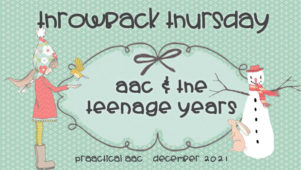
Teenagers are a fun and exciting group to work with. In today’s post, we reach into the archives for some past posts that address some of the issues that arise in serving this age group. Starting AAC in the Teen Years: 3 Considerations for Families & Practitioners How I Do It: Starting AAC with Teens & Young Adults by Angela Adams How I Do It: Pocket Flipbooks for Adults & Teens How I Do It: Pocket Flipbooks for Adults & Teens, Part 2 How I Do It: Pocket Flipbooks for Teens, Part 3 How I Do It: Conversation Practice with Teens and Young Adults by Angela Adams Faces of AAC – Zainab Omar Let’s Hit the Town, AAC Style Bridging Literacy and AAC for Adolescents Communication Strategies for Adolescents as They Transition through Adulthood AAC in Secondary School: Defining Age Respectful
December 20, 2021
by Carole Zangari -
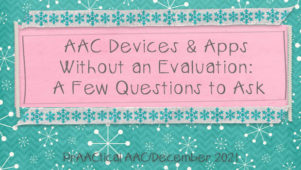
In a perfect world, everyone who needs AAC would participate in a comprehensive assessment to guide the selection of what SGD and/or AAC app will best meet their needs. That evaluation would include a records review, interviews with key stakeholders, observation, direct assessment, and a period of trial use with the communication aids that seem to be the best fit. It’s a complex and time-consuming endeavor, but the feature match process has been the gold standard for AAC device/app selection for several decades. At times, this process is skipped in favor of a quicker approach. Bhodie’s school team already supports several other students with AAC needs and most of them use a popular AAC app on an iPad. Since they are already familiar with that tool and it seems to be working well for other students, they tried it with Bhodie, too. He was successful in using it to request... [Read More...]
December 5, 2021
by Carole Zangari -
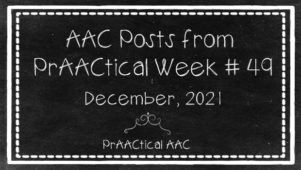
Happy Sunday, AAC friends. Here are some posts you might like. Monday – December Year of Core Vocabulary & School Year of Core Vocabulary Words Tuesday – AAC Link Up Wednesday – Video of the Week: Assessing Classroom AAC Practices Thursday – Throwback Thursday: AAC & the Teenage Years Friday – PráctiCAAmente Conectados Con Links Still have time for a little more AAC? Here are some of our suggestions. 10 Apps to Gift an AAC SLP Helping Beginning Communicators Expand Their Sentence Length 5 Ways to Make Semantic Maps More Effective in AAC Therapy PrAACtically Reading with Karen Natoci: The Family Book How I Do It: A Year of Core Words in Action Have a great week, everyone!
November 11, 2021
by Carole Zangari -
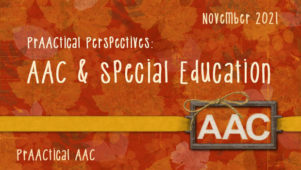
We love learning from people who use AAC and sharing their perspectives on things related to supports and services. So when Mike Hipple reached out with an offer to guest post, we jumped on the chance to publish his thoughts. In this post, Mike, an AAC user who founded the Wisconsin AAC Network, shares his experiences and thoughts on AAC and special education. Enjoy! ::::::::::::::::::::::::::::::::::::::::::::::::::::::::::::::::::::::::::::::::::::::::::::::::: There are many false facts about the augmentative alternative communication community that may interfere with students getting what they need. One AAC false fact that always bugs me as an AAC communicator is all AAC Communicators have a cognitive disability. Mmm, this couldn’t be more wrong. Yes, some do but there is a large number like me that do not. Google says 5.7% of students in public schools during the 2018-19 school year had a cognitive disability. Sadly, when doing research for this paper, I... [Read More...]
November 8, 2021
by Carole Zangari -
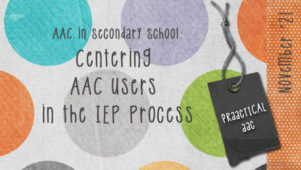
In theory, teenage students with disabilities should play an important role in developing their IEPs and in meetings to discuss them. In practice, this rarely occurs. Today, we’re addressing this important topic with another post in our series focusing on supporting students using AAC during their high school years. AAC SLP Ashley Larisey, an SLP at Community High School District 218 in Oak Lawn, Illinois, is here to discuss ways to support students who use AAC as they prepare to transition out of school. Ashley, who is also an Adjunct Clinical Supervisor and Instructor at Saint Xavier University, has some prAACtical suggestions that are important for school teams, students who use AAC, their families, and school administration. ::::::::::::::::::::::::::::::::::::::::::::::::::::::::::::::::::::::::::::::::::::::::::::::::::::::: Centering AAC Users in the IEP Process When supporting older students who use AAC and are quickly approaching adulthood, our Individualized Education Plans (IEPs), goal development, services, and progress monitoring will... [Read More...]
October 6, 2021
by Carole Zangari -
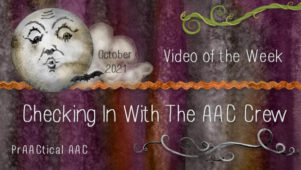
Since October is AAC Awareness Month, we thought it would be the perfect time to feature videos from AAC users. Today, we hear from Levi Parras. Born with Spina Bifida, Levi didn’t need AAC until a brain herniation that occurred when he was a teenager. That experience left him unable to eat, speak, see, or hear. Levi has a lot to say and has used several different communication devices, both low tech and high tech, over the years. You can check out Levi’s Youtube channel and his first two videos below. If you have a chance, subscribe to his channel and leave him a comment or two. Direct link to video – https://www.youtube.com/watch?v=wOfbBxUjHT4&t=5s&ab_channel=AACCREW Direct link to video – https://www.youtube.com/watch?v=tQjylz26YhE&ab_channel=AACCREW
August 9, 2021
by Carole Zangari -
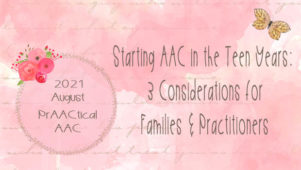
For children with complex communication needs, we often suggest starting AAC in early childhood as a way to support communication, speech, and language development. But in some cases, things don’t work out that way. Children with complex bodies have a lot to learn in those early years and families often prioritize things other than communication for lots of good reasons. They may be building basic survival skills, like breathing, swallowing, and eating. They may be adjusting to feeding tubes or tracheostomies. Some may be helping children learn to sit, hold their heads up, reach for things, or develop mobility skills. Others may be dealing with difficult-to-control seizures, debilitating sleep disorders, or significant medical challenges. Sometimes, things don’t come together to support AAC until years later. William’s team was learning to understand his sensory and behavioral challenges throughout much of elementary school, and exploring ways to support him so that he... [Read More...]
June 21, 2021
by Carole Zangari -
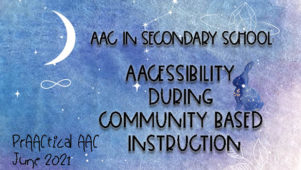
Many students who use AAC spend some time in community-based instruction during their teenage years. In today’s post, AAC SLP Ashley Larisey discusses this topic in a continuation of the AAC in Secondary School series. Ashley is an SLP at Community High School District 218 in Oak Lawn, Illinois. She is also an Adjunct Clinical Supervisor and Instructor at Saint Xavier University. Additionally, Ashley presents on AAC topics at professional conferences. Enjoy! :::::::::::::::::::::::::::::::::::::::::::::::::::::::::::::::::::::::::::::::::::::::::::::::::::::::::::::::::::::: AACcessibility During Community Based Instruction Community-Based Instruction (CBI) is a meaningful, engaging, and highly motivating experience for many students with disabilities, particularly those students who are high-school-aged and beyond. For AAC users, CBI provides opportunities to communicate with unfamiliar communication partners for many different purposes. However, when students are out and about, it can be easy to overlook the ease of access that can exist within the educational environment. However, it is just as important for AAC... [Read More...]
February 8, 2021
by Carole Zangari -
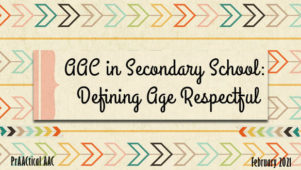
Today, we welcome back AAC SLP Ashley Larisey to these pages for another post in the AAC in Secondary School series. Ashley is an SLP at Community High School District 218 in Oak Lawn, Illinois. She is also an Adjunct Clinical Supervisor and Instructor at Saint Xavier University. In today’s post, she shares thoughts on being age-respectful in choosing content, activities, and materials for high school students who are learning to use AAC. :::::::::::::::::::::::::::::::::::::::::::::::::::::::::::::::::::::::::::::::::::::::::::::::::::::::::::::::::::::: Defining Age-Respectful The terms “age-appropriate” and “functional” are terms that come up frequently when working with older learners with complex communication needs and/or significant cognitive impairments. These students are entitled to receive an education that is aligned with the grade level standards in their state. Instruction should respect that these learners are no longer children, but in fact teenagers or young adults. But what do the terms “age-appropriate” and “functional” really mean? How are those terms... [Read More...]
January 11, 2021
by Carole Zangari -
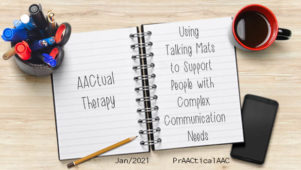
Talking Mats, a powerful tool for helping people with complex needs share their thoughts and advocate for themselves, is a topic we’ve posted about before. Today, we expand that discussion and learn from SLT Katherine Small, an AAC Consultant at the Ace Centre. In the first of a 2-part series, Katherine shares her experience in implementing Talking Mats with her clients. Enjoy! My Experience as a Practitioner who Uses Talking Mats Before training as an SLT, I had a variety of jobs where supporting people to share their views was key. One of the tools I used was ‘In My Shoes’ and I knew how helpful such tools were when I was trying to make sure I gave clients space to think and a means of expression during important conversations. So when I heard about Talking Mats I knew straight away that it would suit my style of working &... [Read More...]









